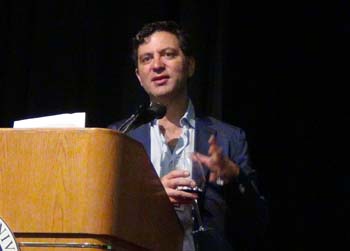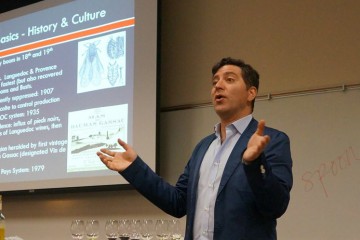Raising the Vision of Central Valley Growers at Grape Day 2014

Raising the Vision of Central Valley Growers at Grape Day 2014
By Matthew Malcolm, Assistant Editor
Grape growers filled the halls of the Viticulture and Enology Research Center and toured the Fresno State vineyards, observing current research projects underway for the benefit of the California grape industry at the 2014 Grape Day. Growers in attendance also had the opportunity to enjoy a complimentary lunch providing by American Vineyard Magazine, and listen to speakers who addressed current industry studies and concerns. The keynote speaker featured at this event was Jamal Rayyis, an internationally noted writer and wine critic.
A Vision of Central Valley Wine — Past, Present & Future
“Wine is something to be enjoyed everyday, and if we want wine to be a regular part of the consumers diet, it has to be affordable; and the Central Valley really provides a way for that,” stated Jamal Rayyis. The purpose of his presentation was to help growers understand the value and potential of the Central Valley’s wine grape industry.
Viticulture in the San Joaquin Valley has been going on successfully since the 1870s. Those who started growing grapes here were trying to grow varieties that worked well for wines of different types, many of which are not common today. It was not until the 1970s, when a boom in wine consumption hit that growers began turning to the common wine grape varieties we see today such as: pinot noir, Cabernet Sauvignon and chardonnay. Before the 1970s though, sweet wine was the dominant type produced in the valley.
The fact of the matter is that consumer preference changes over time, and growers can take advantage of that. “I can tell you forty years ago, people were not drinking Merlot,” Rayyis said. “When it first came on to the market, there was a lot of curiosity; then it got big in the late 1980s and more growers began planting them. People’s wine tastes change, and it would be great if growers here would take advantage of the assets they have in front of them to grow grapes and create wines with distinction, that are not like other wines in California.”
Rayyis explained that growers should continue growing the powerhouse varieties they currently do to supply the market demand, but he believes they can explore other varieties that perhaps grow better here and make Central Valley wines more desirable and valuable.
“Taking advantage of hot climate grapes that have shown to grow well in the Central Valley would be a good thing to incorporate with the more common varieties like Pinot Noir, Merlot and Chardonnay,” expressed Rayyis. He recommended growing Alicante Bushet, a variety with very unique qualities. Although not a highly regarded grape in a lot of places, he believes it would do well here and, if produced in an interesting manner, provoke the interest of many wine consumers.
Other hot climate grapes to consider are Grenache Petit Sirah and Carignane, or Italian varieties such as Aglionico and Negro Amaro. Rayyis pointed out that the varieties from southern Italy make very interesting wines and are grown in conditions very similar to that of the Central Valley, and the Italian growers have even less access to water to irrigate.
As the problem with water in the valley increases, growers are looking for drought resistant rootstocks and also varieties that will thrive under recent conditions. “There are a number of grape varieties that thrive in very arid conditions that produce very aromatic grapes,” explained Rayyis. “But they are just not part of the parlance, and the fact of the matter is that consumers might be willing to try and adopt them if they were available to them.” On that note, Rayyis believes that Central Valley growers can adopt these varieties and have a lot of success with them, culturally and economically. Rayyis’ presentation concluded with an educational wine sampling where growers compared European and Central Valley wines.
Predicting Ideal Harvest Date by Measuring Seed Texture
“I am a firm believer in a tight relationship with grape quality and maturity,” stated Hend Letaief, professor from the Department of Viticulture and Enology at Fresno State. Letaief introduced a new indicator of grape ripening by measuring seed texture. “Depending on climatic conditions and soil type, grape seeds can reach their optimal “textural” maturity up to two weeks before commercial harvest,” she explained.
Most compounds in the berry ripen at the same time, but by following the seed maturation, growers should be able to predict the optimal grape harvesting date up to three or four weeks in advance. This would help wine grape growers in their preparations for harvest, knowing that far ahead of time. In the lab, it takes Letaief only 15 minutes to process samples from a vineyard to calculate the stiffness, toughness and crispness of the seed to identify its maturity level.
Foliar Potassium Applications on Table Grapes
“About 99 percent of all U.S. grown table grapes come from California and over 100 million boxes were shipped to more than 60 countries in 2012,” said Sonet Van Zyl, from the department of viticulture & enology at Fresno State University. Addressing table grape growers, Van Zyl noted that those with early and late ripening varieties tend to get higher prices for their grapes. For those pushing to get an earlier crop and increase the maturity of their fruit, she proceeded to talk about the role of potassium (K).
She noted that K is a key element in grapes, making up three percent of the fresh weight of the fruit. K increases the overall quality of grapes, bringing higher levels of sugar, starch and color accumulation in the fruit. It can also facilitate an earlier harvest or mature a larger crop on the vines. The soil does not always have sufficient K levels, so growers often apply it with foliar sprays. K deficiencies can cause problems such as: restricting the growth of shoots and fruit, increasing the risk of drought stress, and can lead to sugar entrapment and accumulation in the leaves. To avoid these problems and facilitate an earlier harvest, Fresno State researchers applied two foliar applications of K on the vineyard. They made applications of either water or 1.3 g/L of K at veraison and three weeks after.
Results showed that the K treatments caused significant increases in soluble solids in both ‘Sweet Scarlet’ and ‘Sweet Royal’ varieties. It increased berry K content, firmness and color intensity, while berry size and firmness declined significantly. For growers that want an earlier harvest, Van Zyl concluded that applications of K following veraison appear to be promising.
Raisin Rootstock Research
Matthew Fidelibus, an extension specialist at UC Davis, explained that there has been a lot of research going on in rootstock development, primarily in the Central Valley. He urged growers to take greater advantage of it. “Most rootstocks have more tolerance to salts than own-rooted vines do,” he expressed. “In the current situation where we are relying more and more on groundwater, there is less of it available. Overtime if we do not start to see a replenishment of our water supply, we are going to see a decline not only in the availability of water but also in water quality. So we want to be thinking of rootstocks as not only a guard against soil-pests, but also as a helpmeet to get by with lower quality irrigation water.”
Fidelibus said that growers have been using Freedom and Harmony rootstock for about 45 years and they have served them well for many years; however, there have been strains of root knot nematodes that have evolved to overcome the resistance of these rootstocks. “So we have a need for new rootstocks,” he said.
The good news though, is that Dr. Peter Cousins, a geneticist with the USDA-Agricultural Research Service, has developed approximately 800 untested rootstock selections through his rootstock program over the years. “So we have a lot to work with, but we need to narrow this down to a couple of really good rootstocks for grower use,” Fidelibus expressed. “We are going to be very strict with these rootstocks, because we really want a few distinct rootstocks with good qualities.”
Fidelibus explained that they are looking for specific traits to correct some of the issues growers are experiencing with current varieties. For example, potassium is really important for sugar accumulation, a key factor in raisin grape production. Freedom performs much better in potassium intake than 1103P; however, both rootstocks have a high accumulation of nitrogen.
Selma Pete, an early-ripening raisin grape variety, tends to have low levels of zinc. Zinc deficiencies cause poorer fruit-set and often reduces crop-size and berry weight. Growers have to watch carefully for this and may need to supplement the vines with a zinc treatment. A better rootstock, however, with higher zinc accumulation, could correct that. “These are the kind of things we are looking into in developing new rootstocks,” Fidelibus expressed.
“We are looking at new rootstocks to improve the longevity and the performance of your vineyards, he stated. “So we may be able to come up with the best rootstock you could want to have, but it is going to be up to you to be careful in your management, so that you retain the integrity of your rootstocks and get the best performance that you want from them.”
In his concluding remarks, Fidelibus explained that he has been to many vineyards on rootstock where he has seen the graft covered in soil. In this situation, the scions take root and it becomes an own-rooted vine, thus losing the integrity and benefits of the rootstock.
Photosynthesis Chamber to Measure Vineyard Evapotranspiration
Out in the field, graduate student Andrew Beebe, explained the University’s current work on new methods to better identify how to measure the irrigation needs of grapevines to maximize water-use efficiency. This has become exceptionally important in times of drought like this.
Beebe has been working with a photosynthesis chamber, used to measure the photosynthetic rate on a per-vine basis and the evapotranspiration rate of the vines. It is made of an ultra-thin mylar material that covers the vines. The material traps the gases emitted by the plant, so that Beebe can measure CO2 and humidity levels in the canopy. An air conditioning unit is used to blow air into the chamber until it comes to equilibrium. “By measuring the CO2 and humidity going into and on top of the chamber, we can find out how much water the vine is actually using,” Beebe said. “From there, we will be able to determine how many acre-feet of water it takes to produce one ton of fruit.”
In this experiment, Beebe explained that the university has been comparing different regulated deficit irrigation treatments to determine how to maximize yields with less water. They cut water off 50 percent crop ET from fruit-set to veraison and compared that to a deficit irrigation treatment, using 80 percent crop ET throughout the entire season.
“With this data, we can see the effects of reduced water amounts per tonnage, and we are finding that the treatment did not actually effect tonnage,” he said. “We are also monitoring quality, measuring anthocyanin development through the season at different phenological stages, and we are finding there is no difference when using the applied reduced amounts of water. It does not stress the vines, you can use less water and still produce the same tonnage.”
Grape day was a benefit to raisin, table and wine grape growers alike and provided insights regarding the future of the industry, also giving growers practical advise on how to adapt to the changing times for the overall improvement of their operations.
Learn more about the topics addressed at Grape Day by watching video interviews with industry experts who spoke at the event on CaliforniaAgNet.com or AmericanVineyardMagazine.com.



